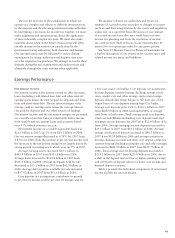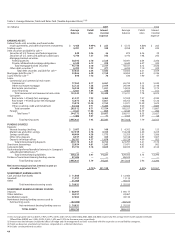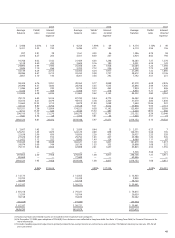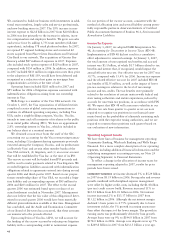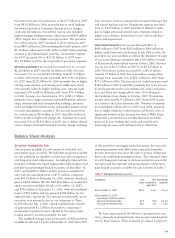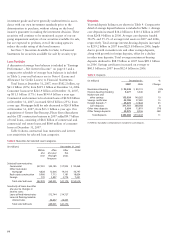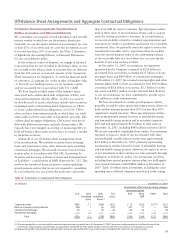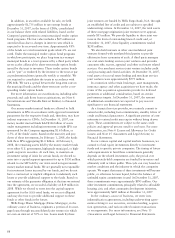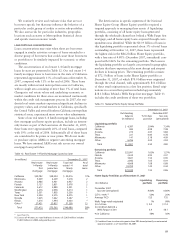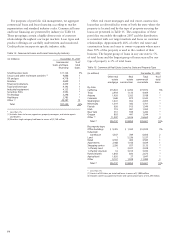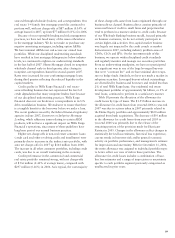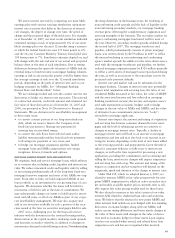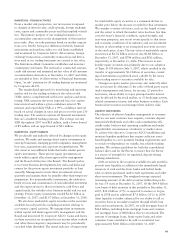Wells Fargo 2007 Annual Report Download - page 56
Download and view the complete annual report
Please find page 56 of the 2007 Wells Fargo annual report below. You can navigate through the pages in the report by either clicking on the pages listed below, or by using the keyword search tool below to find specific information within the annual report.
53
Credit Risk Management Process
Our credit risk management process provides for decentralized
management and accountability by our lines of business. Our
overall credit process includes comprehensive credit policies,
judgmental or statistical credit underwriting, frequent and
detailed risk measurement and modeling, extensive credit
training programs and a continual loan review and audit
process. In addition, regulatory examiners review and perform
detailed tests of our credit underwriting, loan administration
and allowance processes. In 2007, the credit policies related
to residential real estate lending were updated to reflect the
current economic conditions in the industry. Credit policy
was tightened as we made decisions to exit certain poorly
performing indirect channels.
Managing credit risk is a company-wide process. We
have credit policies for all banking and nonbanking opera-
tions incurring credit risk with customers or counterparties
that provide a prudent approach to credit risk management.
We use detailed tracking and analysis to measure credit
Contractual Obligations
In addition to the contractual commitments and arrangements
previously described, which, depending on the nature of the
obligation, may or may not require use of our resources,
we enter into other contractual obligations in the ordinary
course of business, including debt issuances for the funding
of operations and leases for premises and equipment.
Table 11 summarizes these contractual obligations at
December 31, 2007, except obligations for short-term bor-
rowing arrangements and pension and postretirement benefit
plans. More information on those obligations is in Note 13
(Short-Term Borrowings) and Note 20 (Employee Benefits
and Other Expenses) to Financial Statements. The table also
excludes other commitments more fully described under
“Off-Balance Sheet Arrangements, Variable Interest Entities,
Guarantees and Other Commitments.”
We are subject to the income tax laws of the U.S., its
states and municipalities, and those of the foreign jurisdic-
tions in which we operate. We have various unrecognized
tax obligations related to these operations which may require
performance and exception rates and we routinely review
and modify credit policies as appropriate. We have corporate
data integrity standards to ensure accurate and complete
credit performance reporting for the consolidated company.
We strive to identify problem loans early and have dedicated,
specialized collection and work-out units.
The Chief Credit Officer provides company-wide credit
oversight. Each business unit with direct credit risks has a
senior credit officer and has the primary responsibility for
managing its own credit risk. The Chief Credit Officer
delegates authority, limits and other requirements to the
business units. These delegations are routinely reviewed and
amended if there are significant changes in personnel, credit
performance or business requirements. The Chief Credit
Officer is a member of the Company’s Management
Committee. The Chief Credit Officer provides a quarterly
credit review to the Credit Committee of the Board of
Directors and meets with them periodically.
future cash tax payments to various taxing authorities.
Because of their uncertain nature, the expected timing and
amounts of these payments are not reasonably estimable or
determinable. See Note 21 (Income Taxes) to Financial
Statements for more information.
We enter into derivatives, which create contractual
obligations, as part of our interest rate risk management
process, for our customers or for other trading activities.
See “Asset/Liability and Market Risk Management” in this
Report and Note 16 (Derivatives) to Financial Statements for
more information.
Transactions with Related Parties
FAS 57, Related Party Disclosures, requires disclosure of
material related party transactions, other than compensation
arrangements, expense allowances and other similar items
in the ordinary course of business. We had no related party
transactions required to be reported under FAS 57 for the
years ended December 31, 2007, 2006 and 2005.
Risk Management
Table 11: Contractual Obligations
(in millions) Note(s) to Less than 1-3 3-5 More than Indeterminate Total
Financial 1 year years years 5 years maturity (1)
Statements
Contractual payments by period:
Deposits 12 $ 95,893 $ 3,459 $ 1,205 $ 343 $243,560 $344,460
Long-term debt (2) 7, 14 18,397 27,221 22,015 31,760 — 99,393
Operating leases 7 618 976 681 1,408 — 3,683
Purchase obligations (3) 386 539 317 254 — 1,496
Total contractual obligations $115,294 $32,195 $24,218 $33,765 $243,560 $449,032
(1) Includes interest-bearing and noninterest-bearing checking, and market rate and other savings accounts.
(2) Includes obligations under capital leases of $20 million.
(3) Represents agreements to purchase goods or services.


